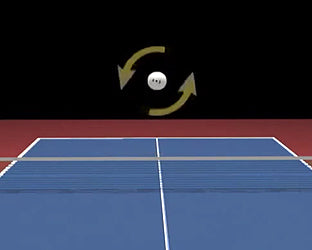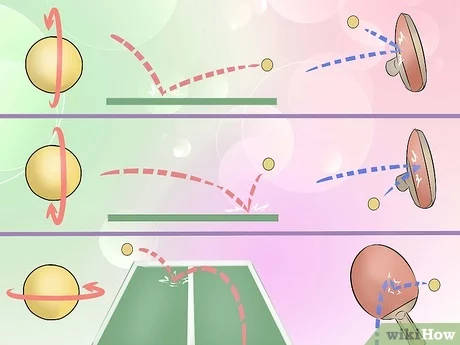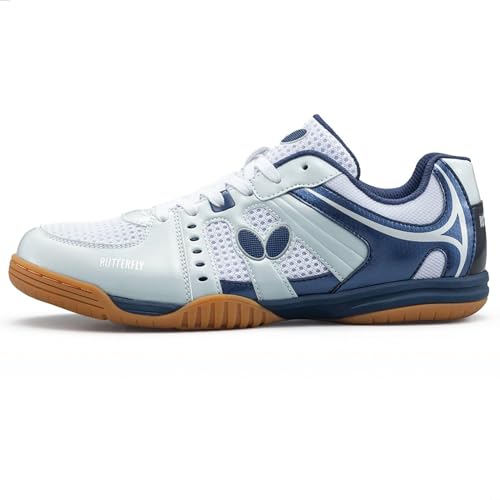To spin a ping pong ball, you need precise control and technique. Mastering this skill can elevate your game significantly.
Spinning a ping pong ball adds a new layer of strategy and fun to your matches. Whether you’re a beginner or looking to improve, understanding the basics of spin can give you an edge. Spin affects the ball’s trajectory, making it harder for your opponent to predict your shots.
In this blog post, we will explore the different types of spins, how to execute them, and tips to practice effectively. With some dedication and practice, you can learn to control the ball better and outsmart your opponents. Let’s dive into the fascinating world of ping pong spin techniques.
Basics Of Ping Pong Spin
Understanding the Basics of Ping Pong Spin can take your game to the next level. Learning how to control the ball’s spin will give you a competitive edge. This blog post will guide you through the different types of spin and explain why spin is essential.
Types Of Spin
There are several types of spin in ping pong:
- Topspin: The ball spins forward. It makes the ball dip quickly after crossing the net.
- Backspin: The ball spins backward. It makes the ball float and bounce low.
- Sidespin: The ball spins sideways. It curves the ball left or right.
- Combination Spin: Mixes topspin, backspin, and sidespin. It is tricky to handle.
Why Spin Matters
Spin is crucial for several reasons:
- Control: Spin helps you control the ball’s speed and direction.
- Deception: Spin can deceive your opponent. It makes your shots unpredictable.
- Defense: Use spin to make it harder for your opponent to return the ball.
To improve your game, focus on practicing each type of spin. Use different angles and speeds. This will make you a versatile player. Remember, mastering spin takes time and practice. Keep at it, and you’ll see improvements in your game.
Equipment Essentials
To master spinning a ping pong ball, you need the right equipment. Your paddle and grip play a key role in executing the perfect spin. Let’s explore these essentials in detail.
Choosing The Right Paddle
The paddle is your primary tool in table tennis. Selecting the right paddle can significantly affect your game. Here are some factors to consider:
- Blade Material: Wood or composite materials.
- Rubber Type: Smooth for control, pips-out for spin.
- Handle Type: Flared, straight, or anatomic.
A table can help in comparing different paddles:
| Paddle Type | Best For | Control | Speed |
|---|---|---|---|
| All-round | Beginners | High | Medium |
| Offensive | Advanced Players | Medium | High |
| Defensive | Defense Strategies | High | Low |
Choose a paddle that suits your playing style. An all-round paddle is ideal for beginners due to its balanced features.
Importance Of Paddle Grip
How you hold your paddle influences your control and spin. There are two primary grips:
- Shakehand Grip: Common in Western countries. Offers good control and versatility.
- Penhold Grip: Popular in Asia. Provides better wrist flexibility for spins.
Each grip has its benefits. Shakehand grip gives you a firm hold and is easier to learn. Penhold grip allows more wrist movement, enhancing your spin abilities.
Practice holding your paddle with each grip. Find which one feels more comfortable and suits your playing style.
Forehand Spin Techniques
Spinning the ping pong ball using forehand techniques can greatly improve your game. Mastering these techniques will give you more control and make your shots unpredictable. This section will guide you through executing topspin and mastering sidespin with your forehand.
Executing Topspin
Topspin is essential for aggressive play. It makes the ball dip quickly, making it harder for your opponent to return.
- Grip: Use a shakehand grip for better control.
- Stance: Stand with feet shoulder-width apart.
- Swing: Start low and finish high. Brush the ball upward.
- Contact: Hit the ball at the highest point of the bounce.
The key is to brush the ball, not hit it flat. This creates the spinning effect. Practice with different speeds to find your comfort zone.
Mastering Sidespin
Sidespin can confuse your opponent. It makes the ball curve, adding a new challenge.
- Grip: Again, use the shakehand grip.
- Stance: Position your body sideways to the table.
- Swing: Swing your paddle horizontally. Brush the side of the ball.
- Contact: Aim to hit the ball when it’s at its peak.
Combining sidespin with topspin can create very tricky shots. Practice these techniques to add variety to your game.
| Technique | Grip | Stance | Swing | Contact Point |
|---|---|---|---|---|
| Topspin | Shakehand | Feet shoulder-width apart | Start low, finish high | Highest point of the bounce |
| Sidespin | Shakehand | Sideways to the table | Horizontal swing | Peak of the bounce |
By mastering these forehand spin techniques, you can control the game’s pace. Your shots will be more unpredictable, giving you an advantage.
Backhand Spin Techniques
Spinning a ping pong ball with your backhand can give you an edge. It allows you to manipulate the ball’s direction and speed. Mastering this technique can confuse your opponent. Here are two essential backhand spin techniques: backspin and sidespin.
Performing Backspin
Backspin makes the ball rotate backward. This causes it to slow down and drop quickly. Follow these steps to perform backspin:
- Hold your paddle at a slight angle.
- Brush the ball from bottom to top.
- Use a gentle and controlled stroke.
It’s important to focus on the angle of your paddle. A slight tilt gives you better control over the spin. Practice with light strokes to master the feel of the spin.
Utilizing Sidespin
Sidespin makes the ball curve to the left or right. It can be very tricky for your opponent. To create sidespin, follow these steps:
- Hold the paddle horizontally.
- Brush the ball from side to side.
- Use a smooth, sweeping motion.
Remember to adjust your paddle angle based on the desired spin direction. Practicing this technique will improve your accuracy and control.
Serving With Spin
Serving with spin in ping pong can give you a big edge. It adds complexity to your game. Your opponent will find it hard to predict the ball’s movement. This skill can take your game to the next level. Let’s explore two main types of spin serves.
Topspin Serve
A topspin serve makes the ball jump forward after it bounces. To perform this serve, brush the top of the ball with your paddle. Aim to make contact with the upper half of the ball. Your paddle should move from low to high. This motion creates the topspin effect. Practice will help you get the right amount of spin. The faster you brush, the more spin you create.
Backspin Serve
A backspin serve makes the ball stop or even move back after it bounces. For this serve, contact the bottom part of the ball. Your paddle should move from high to low. This creates the backspin effect. The ball will slow down once it hits the table. It may even return to your side. This serve can catch your opponent off guard. They might misjudge the ball’s speed. Keep practicing to control the spin better.

Credit: www.youtube.com
Spin In Defensive Play
Defensive play in ping pong requires skill and strategy. Mastering spin in defensive play can disrupt your opponent’s rhythm and force errors. Understanding how to handle and return spin shots is essential to becoming a better player.
Blocking Spin Shots
Blocking spin shots is a crucial skill for defensive players. To effectively block a spin shot, follow these steps:
- Position yourself correctly. Stand at a comfortable distance from the table.
- Angle your paddle to match the incoming spin. For topspin, angle the paddle slightly downward.
- Keep your wrist firm. This will help you maintain control and stability.
- Use a soft touch. Gently absorb the ball’s energy to neutralize the spin.
Remember, blocking requires practice and anticipation. Watch the opponent’s paddle closely to predict the spin direction.
Returning Spin Serves
Returning spin serves can be challenging but manageable with the right techniques. Here’s a step-by-step guide:
- Read the spin. Observe your opponent’s serve motion and paddle angle.
- Adjust your stance. Position yourself to react quickly to the serve.
- Angle your paddle appropriately. For side spin, angle it in the opposite direction of the spin.
- Use a short stroke. This helps to reduce the impact of the spin.
- Stay relaxed. Tension can lead to errors and weak returns.
Practice these steps regularly to improve your ability to handle spin serves. Consistency and patience are key to mastering this aspect of defensive play.
Common Mistakes To Avoid
When learning how to spin a ping pong ball, avoiding common mistakes is crucial. These errors can hinder your progress and make it harder to improve. By recognizing and correcting them, you can enhance your skills faster. Let’s explore some common mistakes and how to avoid them.
Incorrect Paddle Angles
Using the wrong paddle angle can ruin your spin. The paddle angle affects how the ball behaves. A flat paddle won’t create much spin. A paddle tilted too steeply can send the ball off course. Aim for a slight angle. This helps add spin without losing control.
Practice maintaining this angle during play. It will become natural over time. Watch professional players. Notice their paddle angles. Imitate their technique.
Inconsistent Spin
Inconsistent spin can confuse your opponent. But it can also confuse you. Consistency is key for effective spin. Changing your spin too often can lead to mistakes. Focus on mastering one type of spin first. Then, introduce variations.
Practice each spin until you can repeat it reliably. This builds muscle memory. It also boosts your confidence. Consistent spin helps you control the game better.

Credit: m.youtube.com
Advanced Spin Strategies
Advanced spin strategies can elevate your ping pong game. These techniques require precision and practice. Mastering them gives you an edge over opponents. Let’s dive into some advanced spin techniques that can make a difference.
Deceptive Spins
Deceptive spins confuse your opponent. They make it hard to predict the ball’s movement. A common technique is the disguised spin. Use a motion similar to a regular shot. But, change the angle of your paddle at the last moment. This creates an unexpected spin. Opponents often misjudge the ball’s trajectory.
Another method is the no-spin spin. It sounds contradictory, but it works. Pretend to spin the ball, but apply no actual spin. The ball’s straight path can catch opponents off guard. Timing is crucial in executing deceptive spins. Practice helps in perfecting these tricky moves.
Combining Spins
Combining spins adds complexity to your shots. Use topspin and sidespin together. This makes the ball curve and dip. It’s a tough shot to return. Mix backspin with sidespin. The ball will float and veer off course. Opponents struggle to adjust.
Switching spins in quick succession can also be effective. Follow a heavy topspin shot with a heavy backspin. This forces your opponent to adapt quickly. Practice different combinations to see which works best. Mastering these combinations can significantly improve your game.

Credit: www.killerspin.com
Frequently Asked Questions
How Do You Spin A Ping Pong Ball?
To spin a ping pong ball, brush the ball with a quick, upward or downward motion. Use your wrist to generate spin. The angle and speed of your paddle matter.
What Is The Best Way To Practice Spin?
The best way to practice spin is with repetitive drills. Use multi-ball training and focus on consistency. Practicing with a partner can also help improve your spin control.
Why Is Spin Important In Ping Pong?
Spin is important in ping pong because it adds complexity to your shots. It makes the ball harder to return and can control the game. Mastering spin can give you a competitive edge.
How Does Spin Affect Ping Pong Ball Trajectory?
Spin affects the trajectory by changing the ball’s path. Topspin makes the ball dip quickly, while backspin can make it float or move erratically. Mastering spin can confuse opponents.
Conclusion
Spinning a ping pong ball takes practice and patience. Remember to grip the paddle correctly. Use your wrist for more spin. Focus on timing and ball contact. Experiment with different spins and techniques. Watch videos for tips and inspiration. Practice regularly to improve your skill.
Soon, you will see progress. Stay consistent and have fun. Enjoy the game and keep learning.



